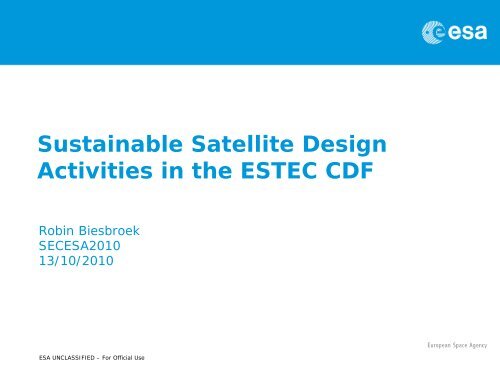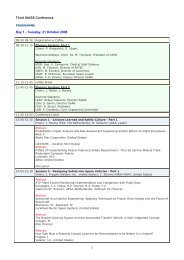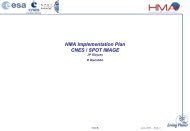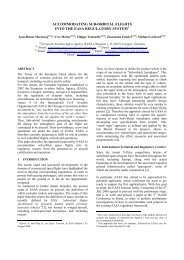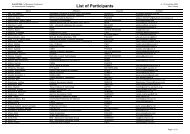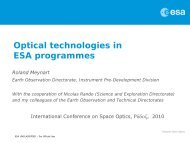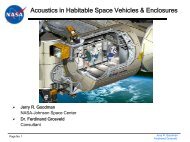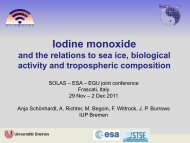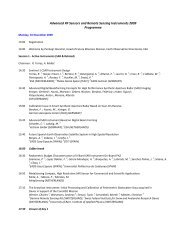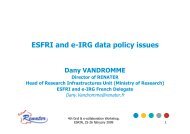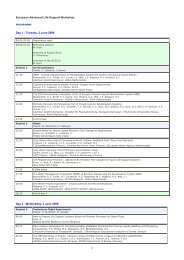Sustainable Satellite Design Activities in the ESTEC CDF - Congrex
Sustainable Satellite Design Activities in the ESTEC CDF - Congrex
Sustainable Satellite Design Activities in the ESTEC CDF - Congrex
You also want an ePaper? Increase the reach of your titles
YUMPU automatically turns print PDFs into web optimized ePapers that Google loves.
<strong>Susta<strong>in</strong>able</strong> <strong>Satellite</strong> <strong>Design</strong><br />
<strong>Activities</strong> <strong>in</strong> <strong>the</strong> <strong>ESTEC</strong> <strong>CDF</strong><br />
Rob<strong>in</strong> Biesbroek<br />
SECESA2010<br />
13/10/2010<br />
ESA UNCLASSIFIED – For Official Use
Table of Contents<br />
– Introduction<br />
– ECOSAT<br />
– Overview<br />
– Introduction to C2C and LCA<br />
– Study logic<br />
– C2C aspects<br />
– LCA aspects<br />
– Trade-offs<br />
– De-orbit<strong>in</strong>g<br />
– Overview<br />
– Aspects us<strong>in</strong>g solids<br />
– Results<br />
– O<strong>the</strong>r aspects<br />
– Team behaviour<br />
– Project behaviour<br />
– O<strong>the</strong>r <strong>CDF</strong> aspects (facility, databases)<br />
– Conclusions and recommendations<br />
ESA <strong>CDF</strong> susta<strong>in</strong>able activities | Rob<strong>in</strong> Biesbroek | SECESA2010 | 13/10/2010 | D/TEC | Slide 2<br />
ESA UNCLASSIFIED – For Official Use
Introduction<br />
– Several activities were launched <strong>in</strong> <strong>the</strong> past years with<strong>in</strong> ESA related to<br />
susta<strong>in</strong>able development<br />
– ESA facilities<br />
– Projects<br />
– Launchers<br />
– ESA’s General Studies Programme (GSP) accepted two proposals <strong>in</strong> this field,<br />
related to satellite design:<br />
– ECOSAT<br />
– De-orbit<strong>in</strong>g<br />
– Both studies were carried out <strong>in</strong> ESA’s Concurrent <strong>Design</strong> Facility (<strong>CDF</strong>)<br />
– State-of-<strong>the</strong>-art facility equipped with a network of computers,<br />
multimedia devices and software tools, which allows a team of<br />
experts from several discipl<strong>in</strong>es to apply <strong>the</strong> concurrent eng<strong>in</strong>eer<strong>in</strong>g<br />
method to <strong>the</strong> design of future space missions<br />
ESA <strong>CDF</strong> susta<strong>in</strong>able activities | Rob<strong>in</strong> Biesbroek | SECESA2010 | 13/10/2010 | D/TEC | Slide 3<br />
ESA UNCLASSIFIED – For Official Use
ECOSAT Overview<br />
– ECOSAT: a pilot experience <strong>in</strong> eco-design applied to<br />
space systems<br />
– The objectives of this project are related to potential<br />
and expected lessons learnt worthwhile for any new<br />
project<br />
– The challenge has been to <strong>in</strong>clude environmental footpr<strong>in</strong>t<br />
assessment at an early stage of <strong>the</strong> design process and to design a<br />
mission encompass<strong>in</strong>g technical solutions that allow:<br />
– Ei<strong>the</strong>r to decrease <strong>the</strong> environmental impact (traditional<br />
eng<strong>in</strong>eer<strong>in</strong>g / LCA approach)<br />
– Or, even better, to create a waste free process <strong>in</strong> which side<br />
products or waste of a process become <strong>in</strong>put materials for<br />
ano<strong>the</strong>r process (C2C approach).<br />
– Eight <strong>CDF</strong> design sessions (31 March – 5 May 2009)<br />
ESA <strong>CDF</strong> susta<strong>in</strong>able activities | Rob<strong>in</strong> Biesbroek | SECESA2010 | 13/10/2010 | D/TEC | Slide 4<br />
ESA UNCLASSIFIED – For Official Use
Introduction to C2C and LCA<br />
– Cradle to Cradle (C2C) is a biomimetic approach to <strong>the</strong> design of<br />
systems that seeks to create systems that are not just efficient<br />
but essentially waste free<br />
– ‘Garbage = food’<br />
– The Sun is <strong>the</strong> source of energy<br />
– Respect diversity<br />
– Life Cycle Analysis (LCA) is a environmental assessment methodology that analyses<br />
<strong>the</strong> complete life cycle of a product or a service and translate <strong>the</strong> associated<br />
emissions and consumptions <strong>in</strong>to environmental impact evaluations.<br />
ESA <strong>CDF</strong> susta<strong>in</strong>able activities | Rob<strong>in</strong> Biesbroek | SECESA2010 | 13/10/2010 | D/TEC | Slide 5<br />
ESA UNCLASSIFIED – For Official Use<br />
– Based on <strong>the</strong> fact that all processes of a life cycle (<strong>in</strong> <strong>the</strong> supply<br />
cha<strong>in</strong>, <strong>in</strong> <strong>the</strong> use phase, <strong>in</strong> <strong>the</strong> end-of-life) cause emissions or<br />
resource extractions.<br />
– LCA does not provide a design methodology.<br />
– LCA is a diagnosis tool which highlights critical environmental<br />
impacts <strong>in</strong> <strong>the</strong> life cycle.
ECOSAT Study Logic<br />
– Comply<strong>in</strong>g with study constra<strong>in</strong>ts to not overlap o<strong>the</strong>r on-go<strong>in</strong>g<br />
susta<strong>in</strong>ability studies, and focus only on satellite design, it was<br />
decided that <strong>the</strong> study team should look <strong>in</strong>to three levels:<br />
– Level 1: Space mission design. Typical <strong>CDF</strong> work but putt<strong>in</strong>g<br />
<strong>the</strong> design emphasis on reduc<strong>in</strong>g or obta<strong>in</strong><strong>in</strong>g a green<br />
footpr<strong>in</strong>t i.e. reduc<strong>in</strong>g space debris, clean propellant etc.<br />
– Level 2: System eng<strong>in</strong>eer<strong>in</strong>g. Improve ground-models,<br />
test<strong>in</strong>g facilities, materials etc.<br />
– Level 3: Earth-based <strong>in</strong>frastructure related to space.<br />
Standards, way of work<strong>in</strong>g, facilities etc.<br />
– The study started with a workshop on C2C given to <strong>the</strong> team<br />
– Unfortunately, after follow<strong>in</strong>g <strong>the</strong> workshop, <strong>the</strong><br />
methodology beh<strong>in</strong>d C2C was still not entirely clear<br />
ESA <strong>CDF</strong> susta<strong>in</strong>able activities | Rob<strong>in</strong> Biesbroek | SECESA2010 | 13/10/2010 | D/TEC | Slide 6<br />
ESA UNCLASSIFIED – For Official Use
ECOSAT C2C aspects<br />
– After <strong>the</strong> workshop, a bra<strong>in</strong>storm<strong>in</strong>g session was held on Level 2 & 3<br />
aspects<br />
– Number of <strong>in</strong>puts received by <strong>the</strong> team……0<br />
– Dur<strong>in</strong>g <strong>the</strong> session, <strong>in</strong> a concurrent way, ideas were formed<br />
– C2C aspects studied <strong>in</strong> ECOSAT were:<br />
1. Certification of used materials<br />
2. <strong>Design</strong> for:<br />
ESA <strong>CDF</strong> susta<strong>in</strong>able activities | Rob<strong>in</strong> Biesbroek | SECESA2010 | 13/10/2010 | D/TEC | Slide 7<br />
ESA UNCLASSIFIED – For Official Use<br />
– Disassembly<br />
– Reuse<br />
– Recycle<br />
3. Identify ‘free’ products, services and possible users
1. Certification of used materials<br />
– Identify used materials<br />
– Rank <strong>the</strong>m accord<strong>in</strong>g to, for example, toxicity<br />
– Apply colour rank<strong>in</strong>g (red = materials to be avoided, green = materials to be<br />
promoted)<br />
– <strong>CDF</strong> has little knowledge on materials used <strong>in</strong> components<br />
ESA <strong>CDF</strong> susta<strong>in</strong>able activities | Rob<strong>in</strong> Biesbroek | SECESA2010 | 13/10/2010 | D/TEC | Slide 8<br />
ESA UNCLASSIFIED – For Official Use<br />
– Level stops at ‘unit’ level<br />
– Even elsewhere with<strong>in</strong> ESA, accurate material lists are not well known<br />
– Known only to suppliers to <strong>the</strong> satellite contractor company<br />
– This is <strong>the</strong>ir core bus<strong>in</strong>ess → stays secret<br />
– Exception: propellants<br />
– Processes have an impact on <strong>the</strong> eco-footpr<strong>in</strong>t<br />
– Typically >40% of a satellite is alum<strong>in</strong>ium<br />
– Mach<strong>in</strong>ed out of massive block that has been forged<br />
– Impact of forg<strong>in</strong>g, <strong>the</strong>rmal treatments, etc. should be taken <strong>in</strong>to account<br />
– Is it recycled? Only 5% of <strong>the</strong> energy needed to prdocue metal from bauxite
2a. <strong>Design</strong> for disassembly<br />
– Disassembly by de-orbit<strong>in</strong>g (break-up dur<strong>in</strong>g re-entry)<br />
– In l<strong>in</strong>e with C2C: de-orbit<strong>in</strong>g ‘br<strong>in</strong>gs’ <strong>the</strong> S/C materials back where<br />
<strong>the</strong>y came from<br />
– Carbon extracted from CFRP fall<strong>in</strong>g on ground can act as<br />
nutrients for soil<br />
– Use of origami?<br />
– Create a shape that <strong>in</strong>creases <strong>the</strong> chance of total<br />
dis<strong>in</strong>tegration (crack<strong>in</strong>g path) <strong>in</strong> <strong>the</strong> atmosphere<br />
– More suitable for flexible planar structures<br />
ESA <strong>CDF</strong> susta<strong>in</strong>able activities | Rob<strong>in</strong> Biesbroek | SECESA2010 | 13/10/2010 | D/TEC | Slide 9<br />
ESA UNCLASSIFIED – For Official Use<br />
– Problems with fair<strong>in</strong>g size<br />
– Number of mechanisms
2b. <strong>Design</strong> for reuse<br />
– Advocate modular design<br />
– Reuse units/modules<br />
– Typical aspect of satellite design <strong>in</strong> <strong>the</strong> <strong>CDF</strong><br />
– Indicated by Technology Read<strong>in</strong>ess Level (TRL)<br />
– But: often when a unit is reused, <strong>the</strong> TRL drops a few steps<br />
ESA <strong>CDF</strong> susta<strong>in</strong>able activities | Rob<strong>in</strong> Biesbroek | SECESA2010 | 13/10/2010 | D/TEC | Slide 10<br />
ESA UNCLASSIFIED – For Official Use<br />
– A component may have become obsolete<br />
– A fault <strong>in</strong> <strong>the</strong> design was found<br />
– A way to improve it was found<br />
– The unit does not fit 100%, small changes required<br />
– This is common, even <strong>in</strong> mass-productions<br />
F355 eng<strong>in</strong>e, 1996 version F355 eng<strong>in</strong>e, 1998 version
2c. <strong>Design</strong> for recycle<br />
– On-orbit servic<strong>in</strong>g?<br />
– Servic<strong>in</strong>g module characteristics:<br />
– Will preferably <strong>in</strong>terface with <strong>the</strong> spacecraft for dock<strong>in</strong>g (dock<strong>in</strong>g is<br />
mandatory <strong>in</strong> case of use of a robotic arm)<br />
– Shall have solar panels to generate <strong>the</strong> required power<br />
– Shall hold a robotic arm (double arm with 7 degrees of freedom <strong>in</strong><br />
each of <strong>the</strong> 2 arms)<br />
– Shall hold <strong>the</strong> Orbital Replacement Units (batteries and electronics)<br />
– Shall hold <strong>the</strong> new <strong>in</strong>struments of <strong>the</strong> new mission to replace <strong>the</strong> old<br />
ones<br />
– Shall be able to re-fuel <strong>the</strong> spacecraft for <strong>the</strong> new mission<br />
– Will be able to eventually provide a de orbit module to <strong>the</strong> spacecraft<br />
– Will eventually use astronauts (Extra Vehicular <strong>Activities</strong> (EVA)) to<br />
replace components<br />
– <strong>CDF</strong> can play a role as spacecraft would have to be designed for servic<strong>in</strong>g from<br />
<strong>the</strong> earliest design phases.<br />
– But: many constra<strong>in</strong>ts/guidel<strong>in</strong>es that become worse <strong>in</strong> case of servic<strong>in</strong>g by<br />
astronauts (no sharp edges, rails to hold on to, etc.)<br />
– May only be viable if many satellites are serviced<br />
ESA <strong>CDF</strong> susta<strong>in</strong>able activities | Rob<strong>in</strong> Biesbroek | SECESA2010 | 13/10/2010 | D/TEC | Slide 11<br />
ESA UNCLASSIFIED – For Official Use
3. Identify ‘free’ products<br />
– Piggy-back launch opportunities<br />
– Share of ground antenna use<br />
– Share of ground equipment use<br />
– Share of computer capacity on ground-stations<br />
– Reuse transport conta<strong>in</strong>ers<br />
– Typically considered with satellite design<br />
– Typically done with low-cost satellite design<br />
ESA <strong>CDF</strong> susta<strong>in</strong>able activities | Rob<strong>in</strong> Biesbroek | SECESA2010 | 13/10/2010 | D/TEC | Slide 12<br />
ESA UNCLASSIFIED – For Official Use
ECOSAT C2C aspects: conclusions<br />
– Unfortunately, <strong>the</strong> bra<strong>in</strong>storm<strong>in</strong>g did not lead to a clear Level 1 def<strong>in</strong>ition<br />
– Nor to a clear application of <strong>the</strong> C2C process applied to a space mission<br />
– An alternative approach was taken:<br />
– Test<strong>in</strong>g of LCA (Life-Cycle Analysis) software and methodology<br />
– Trade-offs<br />
– Launcher<br />
– <strong>Satellite</strong><br />
– <strong>Design</strong> of an Earth observation satellite (Investigat<strong>in</strong>g <strong>the</strong> correlation between<br />
global climate change and thickness of <strong>the</strong> polar ice gaps) tak<strong>in</strong>g <strong>in</strong>to account<br />
trade-offs <strong>in</strong>clud<strong>in</strong>g LCA <strong>in</strong>dex, with <strong>the</strong> focus:<br />
– De-orbit technologies<br />
– Materials (Solar panels, propellant, structure)<br />
ESA <strong>CDF</strong> susta<strong>in</strong>able activities | Rob<strong>in</strong> Biesbroek | SECESA2010 | 13/10/2010 | D/TEC | Slide 13<br />
ESA UNCLASSIFIED – For Official Use
ECOSAT de-orbit<strong>in</strong>g system trade-off<br />
– Bad LCA <strong>in</strong>dices were obta<strong>in</strong>ed for <strong>in</strong>flatable & cold-gas propulsion systems (due to high<br />
mass → large amount of alum<strong>in</strong>ium) and Xenon-based electrical propulsion (due to difficult process to<br />
obta<strong>in</strong> Xenon)<br />
– With <strong>the</strong> exception of Xenon, any normal <strong>CDF</strong> system trade-off (m<strong>in</strong>imiz<strong>in</strong>g mass, typically) would lead to<br />
<strong>the</strong> same result!<br />
– Level 1 design was done for de-orbit<strong>in</strong>g us<strong>in</strong>g mono-propellant (slow re-entry) & solid propulsion<br />
ESA <strong>CDF</strong> susta<strong>in</strong>able activities | Rob<strong>in</strong> Biesbroek | SECESA2010 | 13/10/2010 | D/TEC | Slide 14<br />
ESA UNCLASSIFIED – For Official Use
ECOSAT sub-system trade-offs<br />
– Material selection for <strong>the</strong> satellite structure<br />
– Solar panel material trade-off (GaAs versus Si cells)<br />
– Reduction of <strong>the</strong> amount of used ground-stations by us<strong>in</strong>g a relay satellite<br />
– Launcher propellants and green propellants have a high impact on <strong>the</strong> eco-footpr<strong>in</strong>t<br />
– Improvement of clean-room air-condition<strong>in</strong>g by better ceil<strong>in</strong>gs, new doors<br />
– Reduction of paper work dur<strong>in</strong>g Research and Development processes<br />
– Reduction of amount of travel dur<strong>in</strong>g projects<br />
– Office conditions for project team members (air-condition<strong>in</strong>g)<br />
– Tele-test<strong>in</strong>g and <strong>in</strong>creased use of virtual models and simulation for spacecraft test<strong>in</strong>g<br />
– Increas<strong>in</strong>g <strong>the</strong> amount of satellite autonomy.<br />
– Aga<strong>in</strong> it was concluded that most trade-offs were performed <strong>in</strong> any satellite design (not<br />
tak<strong>in</strong>g <strong>in</strong>to account environmental issues):<br />
– satellite structures are often based on CFRP due to its good structure qualities<br />
(high stiffness at low mass)<br />
– While a Si cell would receive a better LCA <strong>in</strong>dex than a GaAs cell, <strong>the</strong> LCA trade-<br />
off would still favour GaAs cells due to <strong>the</strong>ir lower mass (<strong>the</strong> LCA <strong>in</strong>dex of <strong>the</strong><br />
entire solar panels system is lower than a Si system)<br />
ESA <strong>CDF</strong> susta<strong>in</strong>able activities | Rob<strong>in</strong> Biesbroek | SECESA2010 | 13/10/2010 | D/TEC | Slide 15<br />
ESA UNCLASSIFIED – For Official Use
De-orbit<strong>in</strong>g study<br />
– Cont<strong>in</strong>u<strong>in</strong>g <strong>in</strong> <strong>the</strong> field of de-orbit<strong>in</strong>g<br />
– Kick-off on <strong>the</strong> 3rd June 2009 and f<strong>in</strong>ish<strong>in</strong>g with an Internal<br />
F<strong>in</strong>al Presentation on <strong>the</strong> 16th July 2009<br />
– The objective was to create an ‘add-on’ package that can<br />
easily be attached to a spacecraft<br />
– <strong>in</strong> l<strong>in</strong>e with “design for reuse”<br />
– The <strong>CDF</strong> team assessed, more <strong>in</strong> detail, requirements stated <strong>in</strong><br />
<strong>the</strong> Code of Conduct for Space Debris Mitigation<br />
– ESA satellites with<strong>in</strong> certa<strong>in</strong> regions (LEO/MEO/GEO) required to de-<br />
or re-orbit with<strong>in</strong> 25 years<br />
– In case <strong>the</strong> total casualty risk is larger than 10 -4 , uncontrolled re-<br />
entry is not allowed<br />
– Solid rocket motors releas<strong>in</strong>g burn products larger than 1mm <strong>in</strong>to<br />
orbit shall not be used<br />
– Different options were assessed (same system trade-off, however without LCA<br />
<strong>in</strong>dex)<br />
– Two basel<strong>in</strong>es were selected. The only basel<strong>in</strong>e allow<strong>in</strong>g for an immediate re-<br />
entry (i.e. controlled re-entry) was based on solid-propulsion<br />
– Same option as ECOSAT<br />
ESA <strong>CDF</strong> susta<strong>in</strong>able activities | Rob<strong>in</strong> Biesbroek | SECESA2010 | 13/10/2010 | D/TEC | Slide 16<br />
ESA UNCLASSIFIED – For Official Use
De-orbit<strong>in</strong>g aspects us<strong>in</strong>g solids<br />
– High thrust level of solids<br />
– The thrust level should be low enough not to rip <strong>the</strong> satellite apart when ignited<br />
i.e. caus<strong>in</strong>g more space debris!<br />
– In this study, <strong>the</strong> acceleration caused by <strong>the</strong> thrust was limited to 0.04 g, similar<br />
to g-force limits on geostationary satellites<br />
– The amount of burn products released <strong>in</strong> space<br />
– The Code of Conduct for Space Debris Mitigation requires that solid rocket<br />
motors releas<strong>in</strong>g burn products larger than 1mm <strong>in</strong>to orbit shall not be used<br />
– This was solved by select<strong>in</strong>g alum<strong>in</strong>ium-free propellants.<br />
– Autonomy<br />
– Typically satellite operators tend to operate spacecraft until a critical sub-system<br />
fails, or contact is lost. In this case, a de-orbit sequence won’t be possible unless<br />
<strong>the</strong> de-orbit<strong>in</strong>g package can be managed autonomously<br />
– Even if <strong>the</strong>re is no malfunction, and it’s required to de-orbit, operators try to get<br />
away with it (apply for ‘waivers’, or cont<strong>in</strong>ue until propellant runs out)<br />
– Solid propulsion seems <strong>the</strong> best solution for implement<strong>in</strong>g an autonomous<br />
system, as <strong>the</strong>y require only little energy to be ignited (us<strong>in</strong>g a small primary<br />
battery to supply power) and have a short duration thrust<br />
– One problem rema<strong>in</strong><strong>in</strong>g is how to achieve <strong>the</strong> correct attitude of <strong>the</strong> spacecraft;<br />
this was <strong>in</strong>vestigated at high level but requires fur<strong>the</strong>r detail<br />
ESA <strong>CDF</strong> susta<strong>in</strong>able activities | Rob<strong>in</strong> Biesbroek | SECESA2010 | 13/10/2010 | D/TEC | Slide 17<br />
ESA UNCLASSIFIED – For Official Use
De-orbit<strong>in</strong>g study results<br />
– A modular design was proposed<br />
– Number of motors depend<strong>in</strong>g on<br />
satellite mass & orbit<br />
– The design has been compared to <strong>the</strong> option<br />
of <strong>in</strong>creas<strong>in</strong>g <strong>the</strong> satellite’s propellant tanks<br />
(used for o<strong>the</strong>r purposes) <strong>in</strong> order to carry<br />
enough propellant to de-orbit<br />
– It was found that <strong>in</strong> all cases <strong>the</strong> de-orbit<strong>in</strong>g package was heavier than simply<br />
add<strong>in</strong>g more propellant<br />
– This would imply that satellite designs would typically use <strong>the</strong> latter option i.e.<br />
add<strong>in</strong>g more propellant.<br />
– Still, <strong>the</strong> de-orbit<strong>in</strong>g package offers some advantages:<br />
– it offers a simple design (‘add-on package’) m<strong>in</strong>imiz<strong>in</strong>g impact on<br />
programmatics and cost, and allow<strong>in</strong>g for a smaller on-board<br />
propulsion system (used for attitude control, for example)<br />
– Fur<strong>the</strong>rmore <strong>the</strong> system could be attached to a launcher’s upperstage<br />
<strong>in</strong> order to de-orbit it.<br />
– In <strong>CDF</strong> studies, <strong>the</strong> Code of Conduct for Space Debris Mitigation is always<br />
followed<br />
ESA <strong>CDF</strong> susta<strong>in</strong>able activities | Rob<strong>in</strong> Biesbroek | SECESA2010 | 13/10/2010 | D/TEC | Slide 18<br />
ESA UNCLASSIFIED – For Official Use
Team behaviour<br />
– The subject of susta<strong>in</strong>ability motivated <strong>the</strong> team<br />
– Made ‘aware’ of <strong>the</strong> situation<br />
– Team members cont<strong>in</strong>ued <strong>in</strong> this trend (e.g. videoconferenc<strong>in</strong>g)<br />
– However, <strong>the</strong> team found it difficult to understand <strong>the</strong> C2C methodology<br />
– Except for material selection; but typically <strong>CDF</strong> team members do not<br />
have that knowledge (stays with supplier)<br />
– LCA approach however was easily adapted<br />
– More <strong>in</strong> l<strong>in</strong>e with eng<strong>in</strong>eer<strong>in</strong>g activities<br />
– Need to th<strong>in</strong>k ‘out of <strong>the</strong> box’, which is difficult for many<br />
– C2C expert: ‘Use Ariane 5 ma<strong>in</strong> stage as ocean reef after splash-down, by<br />
apply<strong>in</strong>g special coat<strong>in</strong>gs’; a simple idea that no-one thought of<br />
– C2C expert: ‘Space exploration is good because it allows human to live on<br />
o<strong>the</strong>r planets’; an idea that is a maybe bit too much out of <strong>the</strong> box..<br />
– A group of C2C experts should be <strong>in</strong>tegrated <strong>in</strong>to <strong>the</strong> team for thoughts<br />
beyond current procedures & standards<br />
ESA <strong>CDF</strong> susta<strong>in</strong>able activities | Rob<strong>in</strong> Biesbroek | SECESA2010 | 13/10/2010 | D/TEC | Slide 19<br />
ESA UNCLASSIFIED – For Official Use<br />
– Like how James Cameron is on <strong>the</strong> NASA Advisory Council board
Project behaviour and o<strong>the</strong>r <strong>CDF</strong> aspects<br />
– When contact<strong>in</strong>g a project manager ask<strong>in</strong>g permission to <strong>in</strong>vestigate how we<br />
could improve <strong>the</strong> eco-footpr<strong>in</strong>t of his project, <strong>the</strong> answer was LEAVE US<br />
ALONE!<br />
– This answer is logical: it is seen as an extra constra<strong>in</strong>t<br />
– After years of optimiz<strong>in</strong>g <strong>the</strong> project to<br />
cost/risk/mass/programmatics/etc.<br />
– Management should be conv<strong>in</strong>ced that:<br />
– This is not pos<strong>in</strong>g extra constra<strong>in</strong>ts<br />
– This actually reduces cost/risk/programmatics/mass<br />
– Non-toxic fuel; reduces safety regulations, time schedule and<br />
<strong>the</strong>refore cost<br />
– Replace many project travels by videoconferenc<strong>in</strong>g, sav<strong>in</strong>g<br />
almost 1 k€ per travel<br />
– <strong>CDF</strong> is a good place to start as project designs start <strong>in</strong> <strong>the</strong> <strong>CDF</strong><br />
– The <strong>CDF</strong> has a fantastic videoconferenc<strong>in</strong>g system; used by o<strong>the</strong>r<br />
projects as well; sav<strong>in</strong>g ±4 travels per week<br />
– Large room air-condition<strong>in</strong>g still difficult (air quality, cold�warm)<br />
– Install plants<br />
– Databases (for LCA <strong>in</strong>put) miss<strong>in</strong>g → LCA results used with caution<br />
ESA <strong>CDF</strong> susta<strong>in</strong>able activities | Rob<strong>in</strong> Biesbroek | SECESA2010 | 13/10/2010 | D/TEC | Slide 20<br />
ESA UNCLASSIFIED – For Official Use
Conclusions and recommendations<br />
– The <strong>CDF</strong> team welcomed <strong>the</strong> first studies on susta<strong>in</strong>able design<br />
– High (and last<strong>in</strong>g) motivation<br />
– Difficult to implement C2C th<strong>in</strong>k<strong>in</strong>g<br />
ESA <strong>CDF</strong> susta<strong>in</strong>able activities | Rob<strong>in</strong> Biesbroek | SECESA2010 | 13/10/2010 | D/TEC | Slide 21<br />
ESA UNCLASSIFIED – For Official Use<br />
– A mixed team is recommended (non-eng<strong>in</strong>eers etc.)<br />
– Talk to companies that have successfully implemented C2C<br />
– C2C would normally not be applied to satellite design<br />
– Need to th<strong>in</strong>k bigger: entire programme<br />
– Often, <strong>CDF</strong> designs already focus, <strong>in</strong>directly, on susta<strong>in</strong>able designs<br />
– Mass reduction<br />
– Reuse<br />
– Identification of free products (shar<strong>in</strong>g costs)<br />
– LCA tool was easy to use (system trade-offs performed)<br />
– Improvement of databases w.r.t. space qualified components<br />
– The <strong>CDF</strong> allows early implementation of susta<strong>in</strong>able design with<strong>in</strong> project<br />
– Material & propellant selection, de-orbit<strong>in</strong>g, programmatics etc.


